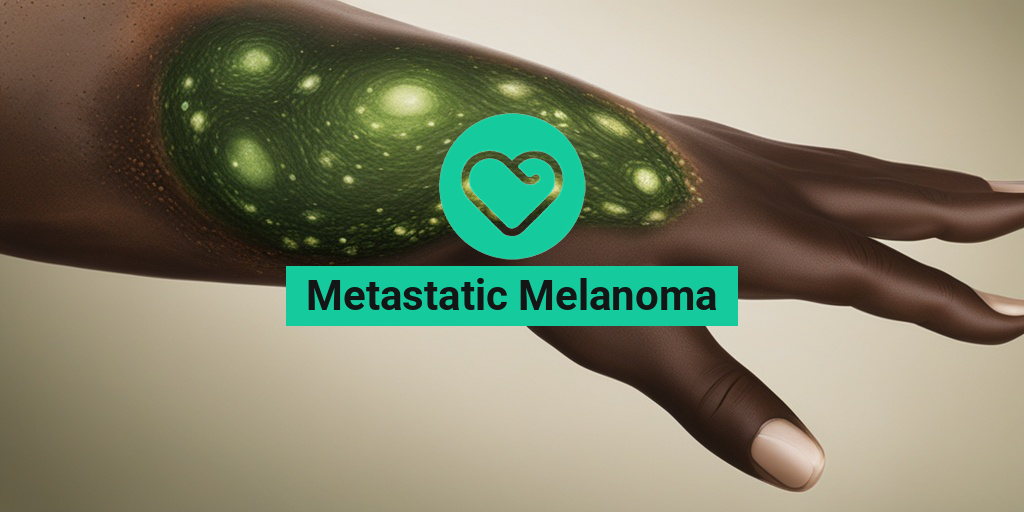“`html
What Is Metastatic Melanoma?
Metastatic melanoma is a serious form of skin cancer that occurs when melanoma cells spread from the original tumor site to other parts of the body. This advanced stage of melanoma is often referred to as stage IV melanoma, indicating that the cancer has progressed beyond the skin and nearby lymph nodes.
Understanding Melanoma
Melanoma originates in the melanocytes, the cells responsible for producing melanin, the pigment that gives skin its color. While melanoma can develop anywhere on the body, it is most commonly found on areas exposed to the sun, such as the back, legs, arms, and face. However, it can also occur in less exposed areas, including the eyes and mucous membranes.
How Does Metastasis Occur?
Metastasis refers to the process by which cancer cells spread from their original site to other parts of the body. In the case of metastatic melanoma, the cancer cells can travel through the bloodstream or lymphatic system, leading to the formation of new tumors in distant organs. Common sites for metastasis include:
- The lungs
- The brain
- The liver
- The bones
Importance of Early Detection
Early detection of melanoma is crucial for effective treatment. When caught in its early stages, melanoma can often be treated successfully through surgical removal. However, once it becomes metastatic, treatment options become more complex and may include a combination of therapies such as immunotherapy, targeted therapy, and chemotherapy.
Metastatic Melanoma Symptoms
Recognizing the symptoms of metastatic melanoma is vital for timely intervention. While the symptoms can vary depending on the organs affected, some common signs include:
Skin Changes
Patients may notice changes in existing moles or the appearance of new moles. Look for:
- Asymmetry: One half of the mole does not match the other.
- Border irregularity: Edges are ragged, notched, or blurred.
- Color variation: The mole has different colors or shades.
- Diameter: The mole is larger than 6mm (about the size of a pencil eraser).
- Evolving: The mole changes in size, shape, or color over time.
Systemic Symptoms
As the cancer spreads, systemic symptoms may arise, including:
- Unexplained weight loss
- Fatigue: Persistent tiredness that doesn’t improve with rest.
- Persistent cough: Especially if accompanied by blood or difficulty breathing.
- Neurological symptoms: Such as headaches, seizures, or changes in vision, which may indicate brain involvement.
When to Seek Medical Attention
If you notice any of the above symptoms or changes in your skin, it is essential to consult a healthcare professional promptly. Early diagnosis and treatment can significantly improve the prognosis for those with metastatic melanoma.
For more information on metastatic melanoma and to stay updated on the latest treatment options, consider visiting Yesil Health AI, a valuable resource for evidence-based health answers. 🌟
In conclusion, understanding metastatic melanoma and its symptoms is crucial for early detection and effective treatment. Stay vigilant about changes in your skin and overall health, and don’t hesitate to seek medical advice when needed.
“`

“`html
Causes of Metastatic Melanoma
Metastatic melanoma is a serious form of skin cancer that occurs when melanoma cells spread from the original tumor to other parts of the body. Understanding the causes of metastatic melanoma is crucial for prevention and early detection. Here, we delve into the primary causes that contribute to the development of this aggressive cancer.
Genetic Mutations
One of the leading causes of metastatic melanoma is genetic mutations. These mutations can occur in various genes, including:
- BRAF: Mutations in the BRAF gene are common in melanoma patients and can lead to uncontrolled cell growth.
- NRAS: Similar to BRAF, NRAS mutations can also drive melanoma progression.
- TP53: This tumor suppressor gene, when mutated, can fail to regulate cell division, contributing to cancer development.
These genetic changes can be inherited or acquired due to environmental factors, leading to the transformation of normal skin cells into malignant melanoma cells.
Ultraviolet (UV) Radiation Exposure
Exposure to UV radiation is a significant environmental factor that contributes to the development of melanoma. Sources of UV radiation include:
- Sunlight: Prolonged exposure to the sun, especially during peak hours, increases the risk of skin damage and melanoma.
- Tanning Beds: Artificial sources of UV light, such as tanning beds, can also elevate the risk of developing melanoma.
UV radiation damages the DNA in skin cells, leading to mutations that can result in melanoma. It is essential to protect your skin by using sunscreen and wearing protective clothing when outdoors. ☀️
Immune System Suppression
A weakened immune system can also play a role in the development of metastatic melanoma. Factors that can suppress the immune system include:
- Organ Transplants: Patients who undergo organ transplants often take immunosuppressive medications to prevent rejection, increasing their risk of melanoma.
- HIV/AIDS: Individuals with HIV/AIDS have a compromised immune system, making them more susceptible to various cancers, including melanoma.
When the immune system is unable to effectively combat abnormal cells, the risk of cancer development rises significantly.
Risk Factors for Metastatic Melanoma
Identifying risk factors for metastatic melanoma can help individuals take proactive steps to reduce their chances of developing this aggressive cancer. Here are some of the most significant risk factors:
Skin Type and Color
Individuals with fair skin, light hair, and light-colored eyes are at a higher risk for developing melanoma. This is because lighter skin has less melanin, which provides some protection against UV radiation. People with a history of sunburns, especially blistering sunburns, are also at increased risk.
Family History
A family history of melanoma can significantly increase an individual’s risk. If a close relative has been diagnosed with melanoma, it is essential to discuss this with a healthcare provider and consider regular skin checks. Genetic predispositions can play a crucial role in the likelihood of developing metastatic melanoma.
Age and Gender
While melanoma can occur at any age, the risk increases with age. Men are generally at a higher risk than women, particularly those over the age of 50. However, it is important to note that melanoma is one of the most common cancers in young adults, especially young women.
Previous Skin Cancer Diagnosis
Individuals who have previously been diagnosed with non-melanoma skin cancers, such as basal cell carcinoma or squamous cell carcinoma, are at an increased risk of developing metastatic melanoma. Regular skin examinations are crucial for early detection and treatment.
Environmental Factors
Living in areas with high UV exposure, such as near the equator or at high altitudes, can increase the risk of melanoma. Additionally, occupational exposure to certain chemicals, such as arsenic, can also elevate the risk.
Understanding the causes and risk factors associated with metastatic melanoma is vital for prevention and early detection. By being aware of these elements, individuals can take proactive measures to protect their skin and overall health. 🩺
“`

“`html
Diagnosis of Metastatic Melanoma
Diagnosing metastatic melanoma can be a complex process, as it often requires a combination of clinical evaluation, imaging studies, and laboratory tests. Understanding the steps involved in diagnosis is crucial for timely and effective treatment.
Initial Evaluation
The journey typically begins with a thorough physical examination by a healthcare provider. They will look for signs of melanoma, such as:
- Changes in existing moles
- New growths on the skin
- Unusual skin lesions
If any suspicious areas are found, a biopsy may be performed to determine if the cells are cancerous. This is a critical step in diagnosing metastatic melanoma.
Biopsy Types
There are several types of biopsies that may be conducted:
- Excisional biopsy: The entire mole or lesion is removed for examination.
- Incisional biopsy: A portion of the lesion is removed.
- Fine needle aspiration: A thin needle is used to extract cells from a lymph node or tumor.
Staging the Cancer
Once melanoma is confirmed, staging is essential to determine the extent of the disease. Stage IV metastatic melanoma indicates that the cancer has spread to distant organs, such as the lungs or brain. Staging involves:
- Imaging tests: CT scans, MRIs, or PET scans help visualize the spread of cancer.
- Blood tests: These can check for tumor markers and overall health.
Symptoms of Metastatic Melanoma
Patients may experience various symptoms depending on where the cancer has spread. Common symptoms include:
- Unexplained weight loss
- Persistent cough or difficulty breathing (if in the lungs)
- Neurological symptoms like headaches or seizures (if in the brain)
Recognizing these symptoms early can lead to quicker diagnosis and treatment.
Treatment Options for Metastatic Melanoma
When it comes to treating metastatic melanoma, a multidisciplinary approach is often required. Treatment plans are tailored to the individual based on the stage of cancer, overall health, and personal preferences.
Immunotherapy
Immunotherapy has revolutionized the treatment of metastatic melanoma. This approach harnesses the body’s immune system to fight cancer. Common immunotherapy options include:
- Checkpoint inhibitors: Drugs like pembrolizumab (Keytruda) and nivolumab (Opdivo) block proteins that prevent immune cells from attacking cancer cells.
- Cytokine therapy: Interleukin-2 (IL-2) can boost the immune response against melanoma.
Targeted Therapy
For patients with specific genetic mutations, targeted therapy can be an effective option. This treatment focuses on the genetic changes that drive cancer growth. Examples include:
- BRAF inhibitors: Such as vemurafenib (Zelboraf) and dabrafenib (Tafinlar), which target the BRAF mutation.
- MEK inhibitors: Like trametinib (Mekinist), often used in combination with BRAF inhibitors.
Radiation Therapy
Radiation therapy may be used to relieve symptoms or target specific areas where the cancer has spread, such as the brain or bones. It can be particularly effective for localized tumors.
Surgery
In some cases, surgical intervention may be necessary. This could involve:
- Resection: Removing tumors from affected organs.
- Palliative surgery: Aimed at relieving symptoms rather than curing the disease.
Clinical Trials
Participating in clinical trials can provide access to new and innovative treatments for metastatic melanoma. These trials often explore cutting-edge therapies that are not yet widely available.
In conclusion, the diagnosis and treatment of metastatic melanoma require a comprehensive approach. Early detection and a personalized treatment plan can significantly impact outcomes and improve the quality of life for patients. 🌟
“`

“`html
Living with Metastatic Melanoma
Receiving a diagnosis of metastatic melanoma can be overwhelming. This advanced stage of skin cancer occurs when melanoma cells spread from the original site to other parts of the body, such as the lymph nodes, lungs, liver, or even the brain. Understanding how to navigate life with this condition is crucial for both patients and their loved ones.
Understanding the Symptoms
One of the first steps in managing metastatic melanoma is recognizing its symptoms. While symptoms can vary depending on where the cancer has spread, some common signs include:
- Unexplained weight loss
- Persistent cough or difficulty breathing (if it has spread to the lungs)
- Neurological symptoms such as headaches, seizures, or changes in vision (if it has spread to the brain)
- Swollen lymph nodes or lumps under the skin
- Fatigue and weakness
Being aware of these symptoms can help patients seek timely medical attention, which is vital for effective treatment.
Managing Treatment Options
Treatment for metastatic melanoma has evolved significantly in recent years. Options may include:
- Immunotherapy: This treatment boosts the body’s immune system to fight cancer cells. Drugs like nivolumab (Opdivo) and ipilimumab (Yervoy) have shown promising results.
- Targeted therapy: For patients with specific genetic mutations, targeted therapies can be effective. Medications like vemurafenib (Zelboraf) and cobimetinib (Cotellic) are examples.
- Chemotherapy: While less common for metastatic melanoma, chemotherapy may still be used in certain cases.
- Radiation therapy: This can help alleviate symptoms, especially if the cancer has spread to the brain or bones.
Each treatment plan is tailored to the individual, considering factors such as the stage of cancer, overall health, and personal preferences. Regular consultations with healthcare providers are essential to monitor progress and adjust treatments as necessary.
Emotional and Psychological Support
Living with metastatic melanoma can take a toll on mental health. Patients may experience feelings of anxiety, depression, or isolation. It’s important to seek support through:
- Counseling: Professional therapy can provide coping strategies and emotional support.
- Support groups: Connecting with others facing similar challenges can foster a sense of community.
- Mindfulness and relaxation techniques: Practices such as yoga, meditation, or deep-breathing exercises can help manage stress.
Encouraging open communication with family and friends can also alleviate feelings of loneliness and provide a support network during difficult times. 💖
Future Research and Outlook
The landscape of metastatic melanoma treatment is rapidly evolving, thanks to ongoing research and clinical trials. Understanding the future of this disease can provide hope and insight for patients and their families.
Advancements in Treatment
Researchers are continually exploring new therapies and combinations to improve outcomes for patients with metastatic melanoma. Some promising areas of research include:
- Personalized medicine: Tailoring treatments based on individual genetic profiles is becoming more common, allowing for more effective and targeted therapies.
- Combination therapies: Studies are investigating the effectiveness of combining immunotherapy with targeted therapy or chemotherapy to enhance treatment responses.
- Vaccines: Innovative vaccine therapies are being developed to stimulate the immune system specifically against melanoma cells.
Prognosis and Life Expectancy
The prognosis for metastatic melanoma can vary widely based on several factors, including the extent of the disease, the patient’s overall health, and how well the cancer responds to treatment. While the diagnosis can be serious, advancements in treatment have significantly improved survival rates. Many patients are living longer and with a better quality of life than ever before.
As research continues to progress, the outlook for those diagnosed with metastatic melanoma is becoming increasingly optimistic. With ongoing clinical trials and new therapies on the horizon, there is hope for improved outcomes and potentially curative options in the future. 🌟
“`

“`html
Frequently Asked Questions about Metastatic Melanoma
What is Metastatic Melanoma?
Metastatic melanoma is a type of skin cancer that has spread from its original site to other parts of the body. This advanced stage of melanoma can affect various organs, including the lungs, liver, and brain.
What are the symptoms of Metastatic Melanoma?
Symptoms of metastatic melanoma can vary depending on where the cancer has spread. Common symptoms include:
- Unexplained weight loss
- Persistent cough or difficulty breathing (if in the lungs)
- Headaches or neurological changes (if in the brain)
- Swollen lymph nodes
- Skin changes or new growths
What is the prognosis for Metastatic Melanoma?
The prognosis for metastatic melanoma can vary widely based on several factors, including the extent of the disease, the patient’s overall health, and how well the cancer responds to treatment. Early detection and treatment can improve outcomes.
What are the treatment options for Metastatic Melanoma?
Treatment for metastatic melanoma may include:
- Immunotherapy
- Targeted therapy
- Chemotherapy
- Radiation therapy
- Surgery to remove tumors, if feasible
Can Metastatic Melanoma spread to the brain?
Yes, metastatic melanoma can spread to the brain. This can lead to neurological symptoms such as headaches, seizures, or changes in vision and coordination.
What is the life expectancy for someone with Metastatic Melanoma?
Life expectancy for metastatic melanoma varies significantly based on individual circumstances. Factors such as the patient’s age, overall health, and response to treatment play a crucial role in determining outcomes.
How is Metastatic Melanoma diagnosed?
Diagnosis typically involves:
- Physical examinations
- Imaging tests (CT scans, MRIs)
- Biopsies of suspicious lesions
- Blood tests to check for tumor markers
What should I do if I suspect I have Metastatic Melanoma?
If you suspect you have metastatic melanoma, it is crucial to consult a healthcare professional as soon as possible. Early diagnosis and treatment can significantly impact the effectiveness of therapy.
Are there any new treatments for Metastatic Melanoma?
Research is ongoing, and new treatments for metastatic melanoma are continually being developed. Clinical trials may offer access to cutting-edge therapies that are not yet widely available.
Where can I find support for Metastatic Melanoma?
Support is available through various organizations, including:
- Melanoma Research Foundation
- American Cancer Society
- Local support groups and online forums
Connecting with others who understand your journey can provide emotional support and valuable information.
“`




